LCGC Employment and Salary Survey 2022: Exploring the Current Mood
This year’s LCGC North America salary and employment survey examines the current business landscape of the separation science field through the lens of workers. We analyze topics such as salaries, benefits, employment conditions, and the overall economic health of the separations field. By analyzing the data, we also can get an indication as to whether current business trends are having a sizable impact in the separation science field.
The year 2022 has been all about navigating through uncharted territory. With corporations embracing the endemic impact of Covid-19, the business landscape overall is undergoing change on a scale that workers haven’t witnessed in a long time. Once favorable to the employer, the job market has seen a shift back in favor of the employee, and this balance of power has led to an adjustment in how both employees and employers approach the job market. Although this change is not quite a “power to the people” movement, there has been a revitalization among American and global workers as they reexamine their labor in the context of how it impacts their own lives. The result is a newfound appreciation for flexibility and job autonomy, which has led to a debate over employers’ imposing return-to-office (RTO) policies and employees’ resisting this change.
In our annual survey, we report on the overall employment and salary situation for separation scientists, comparing the data to previous years to look for trends (1–4). We have also focused heavily on overall job satisfaction and what separation scientists consider important. Every year, we also ask respondents to share their views on at least one broader workplace trend, varying the topic each year depending on what issues are most pervasive in the workplace. In 2021, we asked respondents to share their views on discrimination in the workplace (4). This year, we focused on what employers want from their workers and what workers want from their employers, asking respondents to comment on a sometimes divisive issue between employers and employees—the implementation of a return-to-office (RTO) policy that eroded some of the freedom employees enjoyed during the pandemic, which was the ability to work remotely and which became a staple of work life during the Covid-19 pandemic. So, what insight did the separation scientists offer about the 2022 employment environment for their field?
The Overall Picture and Respondent Profile
The broader job market has undergone a form of metamorphosis over the past couple years. Coming out of the Covid-19 pandemic, many employers around the world struggled to fill open jobs. This was driven at least in part by the fact that many people began re-examining their relationship to their work, leading to what has been dubbed “the great resignation.” More recently, across the globe and particularly in the United States and western Europe, a rapidly accelerating inflation rate and surging fuel costs had a major impact on the purchasing power of consumers. Although worker shortages coming out of the pandemic had led to higher wages in many fields, these wage increases quickly fell behind inflation, as annual inflation rates have gone above 8% in the United States and higher in other parts of the world, such as the euro zone (5,6). As the second half of 2022 arrived, economic leaders began to implement difficult but necessary strategies to combat the rising inflation rate. In the United States, for example, the Federal Reserve stepped in, raising interest rates in the hope to combat inflation (7).
With so much turmoil occurring in the economy, this year’s survey had significant ground to cover. More than 500 separation scientists from around the world responded to LCGC North America’s 2022 annual employment survey, completed on September 15th, 2022 (see box, “How the Survey was Conducted”).
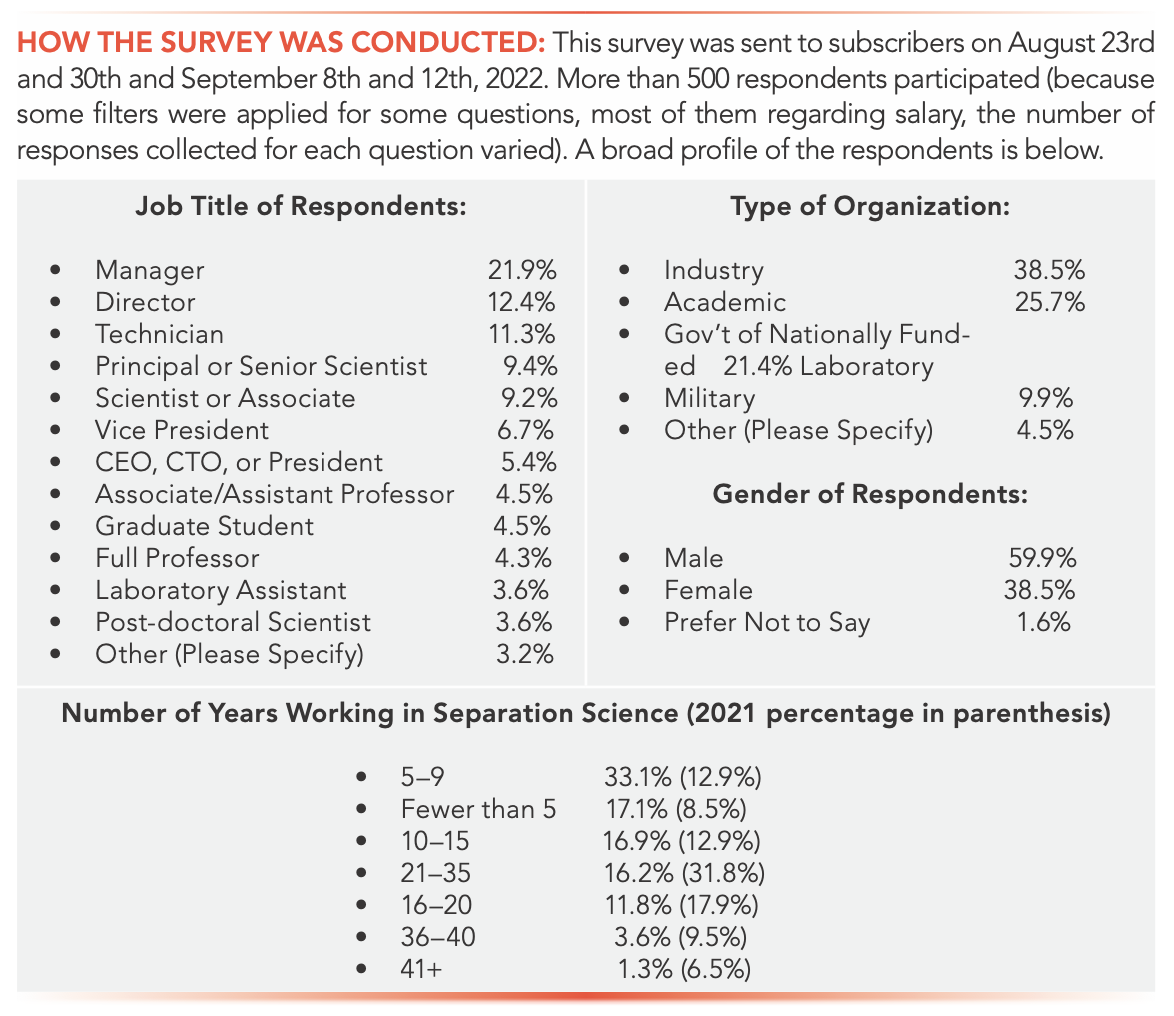
How Much Are Separation Scientists Making?
For this year’s survey, we also continued our trend for recording salaries only for full-time scientists. Like last year, we recorded salaries between $25,000 and $350,000 (Table I). For 2022, reported average salaries were down 12.3% and the overall median salary was down 22%. However, this year, we saw a sharp decrease in respondents with more than 20 years of experience in the field, with only 21.1% of our respondents fitting into this bracket this year, compared to 47.8% last year, which certainly had some impact on the overall median and average salaries we show (see box, “How the Survey was Conducted”). Thus, it is likely that the reported salaries reflect the earnings of a younger workforce and is not an indication that salaries in the separation science field are dropping. In fact, respondents overall reported the opposite. We saw that 48.7% of respondents reported that their salaries rose this year. However, over 29% of respondents acknowledged that their yearly salaries decreased in 2022, and approximately 22% reported that there was no change in their salaries. Meanwhile, when it came to employee bonuses, separation scientists did see a drop. Although it is important to keep in mind that the respondent pool was younger than in 2021, the median bonus was $4,000 USD, whereas in 2021, that figure was $6,000—again, likely reflecting a younger respondent pool (4).
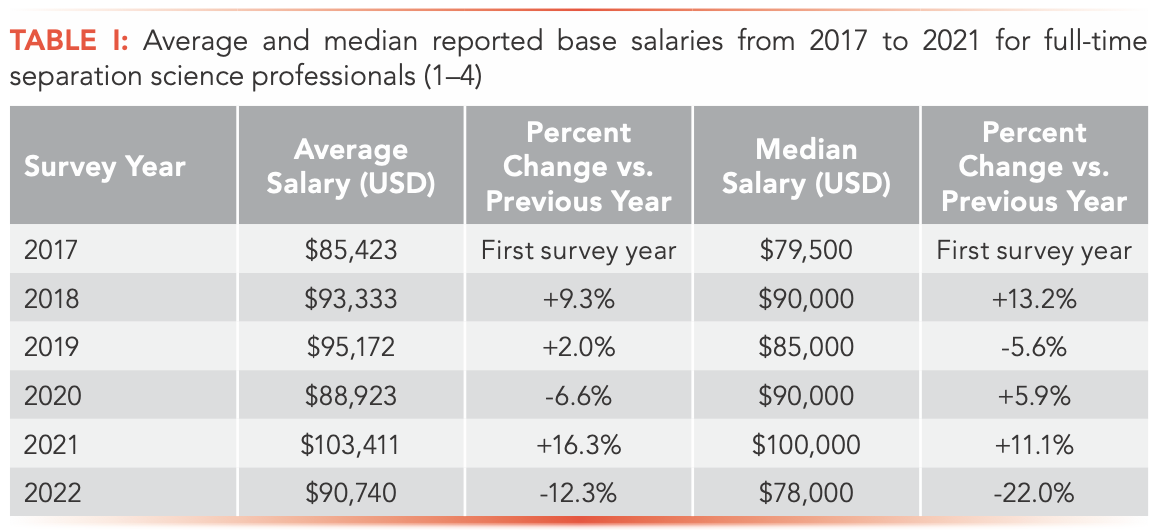
The Search for Greener Pastures: Are Separation Scientists Looking for Better Job Opportunities?
Before focusing on the current workplace and job market trends, we wanted to establish whether separation scientists felt differently about their work environment compared to last year. Despite the recent economic upheaval, our survey found that separation scientists still look favorably at their work environment, with 74.28% answering that their current work environment is better than the previous year (Figure 1a).
FIGURE 1a: “Is your current work environment better than last year?”
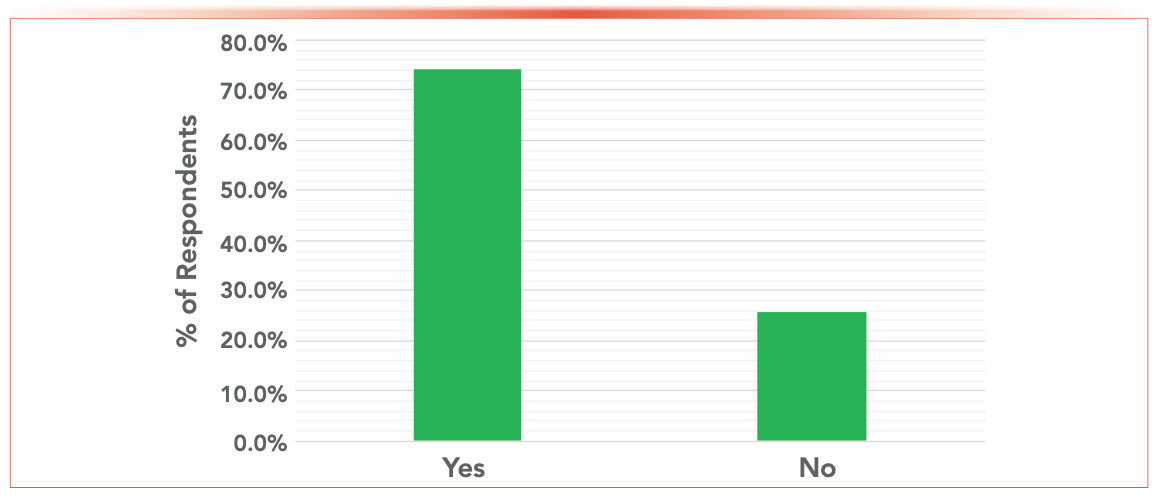
We also inquired about how separation scientists felt about exploring better employment opportunities, juxtaposing those results to what we received in Figure 1a. Figure 1b shows that despite many separation scientists’ feeling encouraged with their work environments, approximately 73% of respondents remain interested in seeking out better opportunities.
FIGURE 1b: “Do you have an interest in seeking better employment opportunities beyond your current situation?”
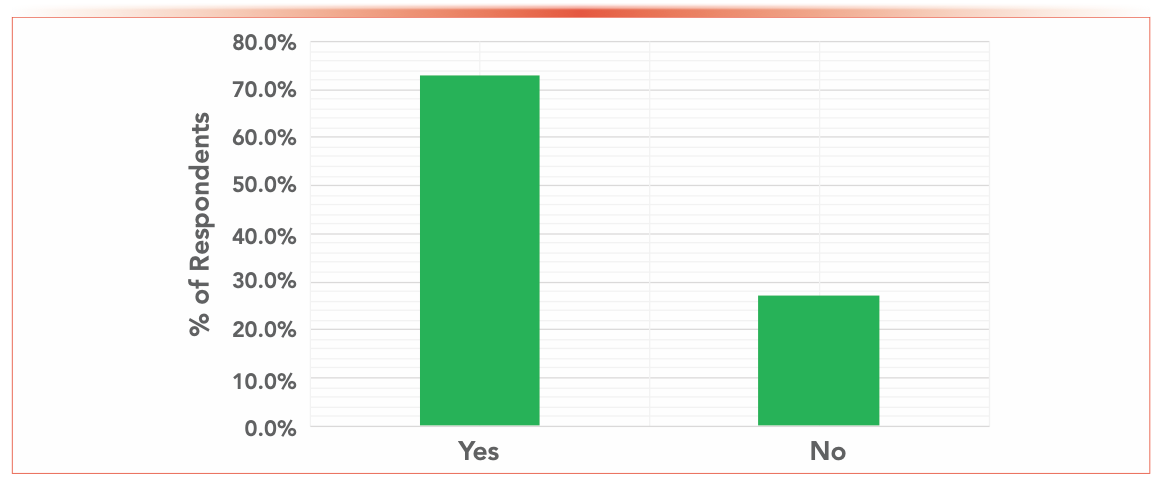
When we asked why people might leave their current jobs, the top answers were to seek a higher salary (21.4%), personal reasons (12.1%), or to look for a new challenge (11.5%). Figure 2 shows the breakdown of responses for the question: “If you plan on seeking alternative employment, which of these options best describes your reason?”
FIGURE 2: “If you plan on seeking alternative employment, which of these options best describes your reason?”
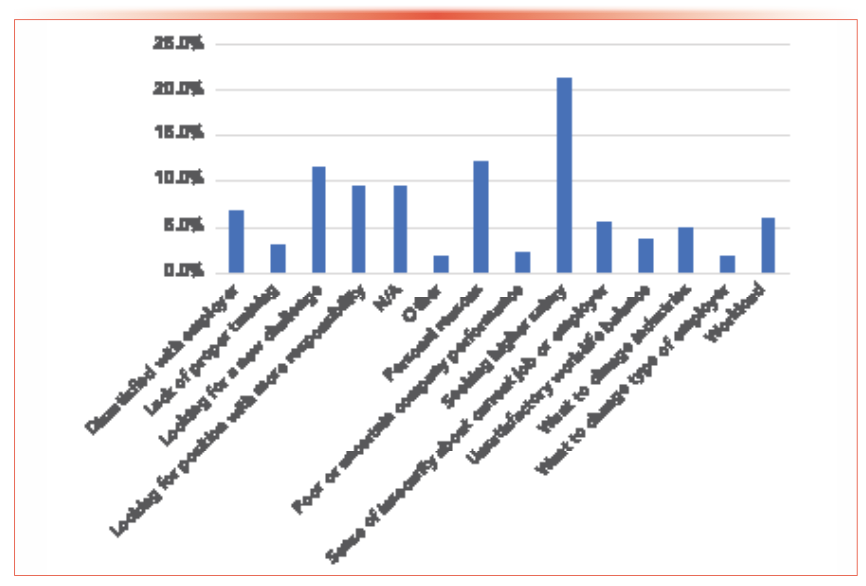
We also asked why dissatisfied workers stay put. Separation science workers who are dissatisfied with their current situations are not necessarily looking to move, however, and we asked why. The top reasons were good salary (22%), good hours (16%), good colleagues (14%), and a convenient location (14%). Figure 3 displays the results of this survey question.
FIGURE 3: If dissatisfied with your employment, but you are not planning to look for alternative employment, which of these options best describes your primary reason?
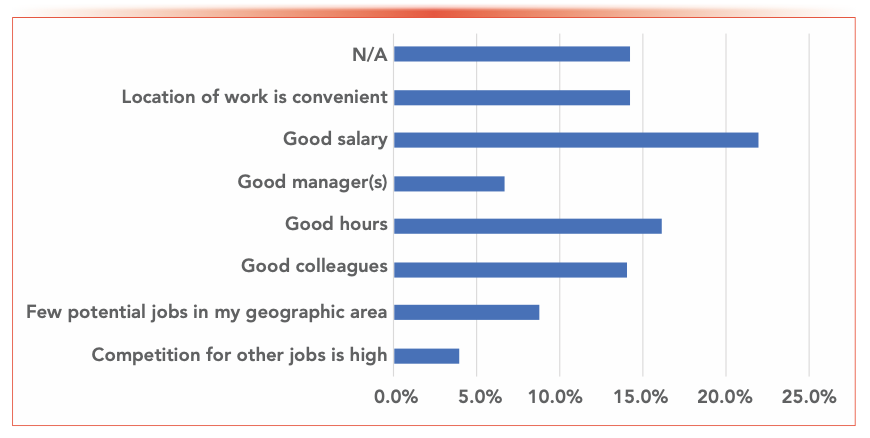
Assessing the Job Market
Another factor that influences whether people change jobs is their sense of the job market. Most respondents (55%) evaluated the job market as being “good” for separation scientists. Our survey found that over 21% considered the job market “excellent,” 20.5% considered it “fair,” and only 2.7% ranked the job market as “poor,” which is indicative of the optimism separation scientists are currently feeling despite current challenges in the economy as a whole. Our findings also revealed that 43% of respondents felt that competition for open roles was moderate and 39% felt that the competition was strong for open jobs. In addition, approximately 17.4% of respondents felt that employers were competing for talent on the open market.
What Separation Scientists Value in a Job
Given that many separation scientists are satisfied with their current work environments yet still interested in considering new job opportunities, we asked respondents to rank workplace items that are most important to them when considering a new job, so that we could compare whether certain factors became more or less important from 2021 to 2022. These factors include retirement benefits, prestige of an organization, the ability to work from home, among others (Table II).
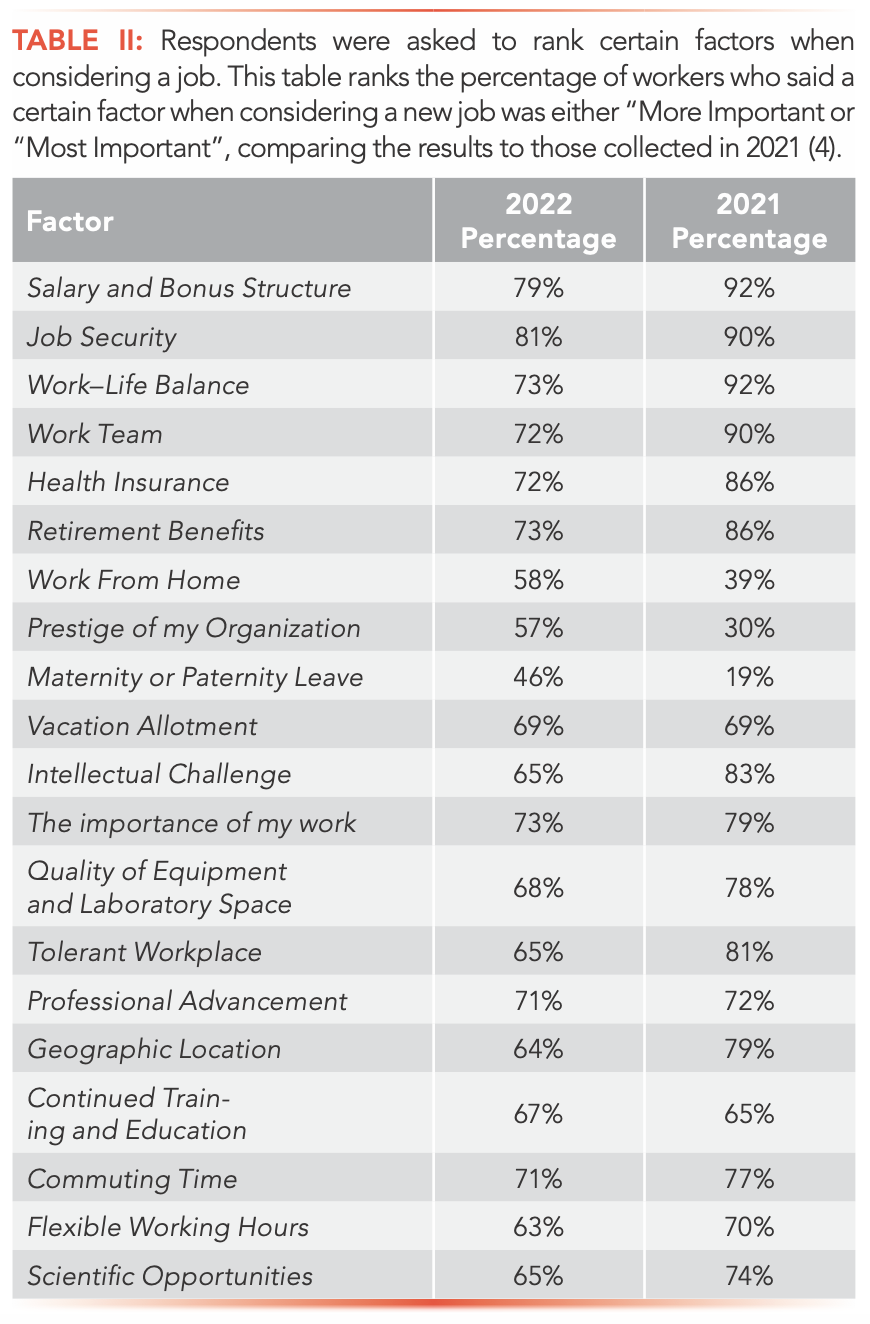
In terms of changes compared to last year, the survey results indicated that respondents put a higher value this year, when compared to last year’s results, on the prestige of their organization, maternity and paternity leave, and the ability to work from home.
The State of Job Security
Apart from asking respondents about what factors are most important to them in a job, we also asked respondents to weigh in on their feelings regarding their job security. Given the current working conditions, it was no surprise that in 2022, workers felt less secure in their positions than in 2021 (20%) (4). For 2022, 40.1% of respondents said that they felt less secure about their jobs, representing an approximate 200% increase from 2021, when only 20% said that.
What was also telling about these results by how many people considered their job security to be stable. In 2021, 54% of respondents said that their job security was unchanged compared to 2020. In 2022, the number of respondents who said there was no change in their job security was cut in half and then some, with only 25.7% of respondents saying that there was no change in their job security. Figure 4 highlights the 2022 results to the job security survey question in greater detail.
FIGURE 4: Separation scientists weighed on how they felt about job security. They were asked whether they felt more secure, less secure, or no change in their current roles.
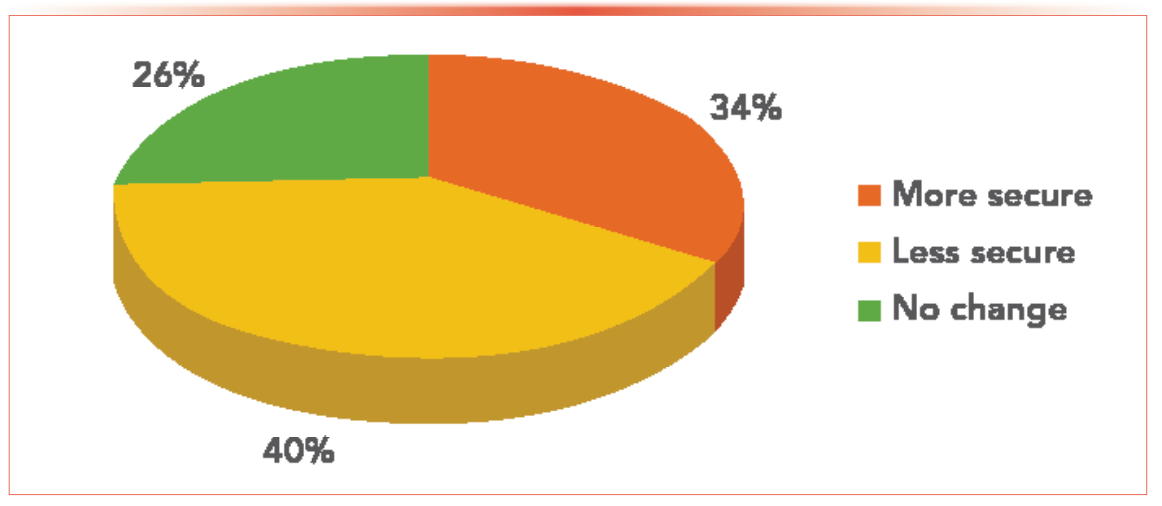
Return-to-Office (RTO) Policies in Separation Science
During the height of the Covid-19 pandemic, remote work was a necessity, and many workers ended up enjoying the advantages of it, such as being freed up from commuting and often having more flexibility in working hours. But as vaccinations became widely available and life began to return to normal, many organizations began requiring that employees be onsite either part-time or full-time, often arguing that collaboration is more effective in person. However, many employees have been unhappy with these return-to-office (RTO) policies.
Our salary and employment survey this year attempted to discern how the separation science field has been impacted by this trend. We first asked respondents to answer whether their organization has such a policy or not. Approximately two thirds (66.4%) of respondents said that their organization has established an RTO policy, 27.7% of respondents said their organization has no RTO mandate, and a small minority (5.9%) answered that their organization does not currently have an RTO policy but is in the process of developing one.
However, the implementation of an RTO policy has not been received poorly. In fact, the results show that most of the respondents are fine with it (Figure 5). Of the respondents, 64% said they believe that most employees supported their employers’ RTO policy, whereas only 21% of respondents indicated that many employees at their company were in opposition. Meanwhile, 15% of respondents indicated that there was no consensus among workers, with approximately half supporting the policy and half opposing it. Most likely, this acceptance of the need to be onsite reflects the fact that most of our survey respondents either work in a laboratory, oversee a laboratory, or do work that is otherwise closely connected to laboratory work.
FIGURE 5: An examination of how separation scientists feel about their employer’s RTO policy. The question was “If your company does have an in-office or RTO policy, do you think most employees support it?”
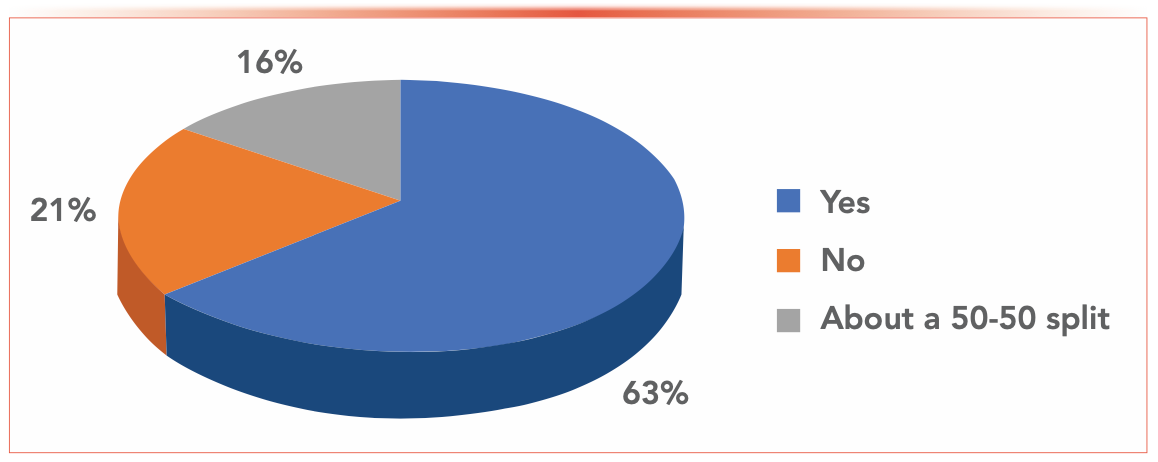
In spite of this, many respondents (41.6%) said that RTO policies have negatively impacted hiring at their company (Figure 6).
FIGURE 6: An examination of how RTO policies have impacted hiring across the separation science industry.
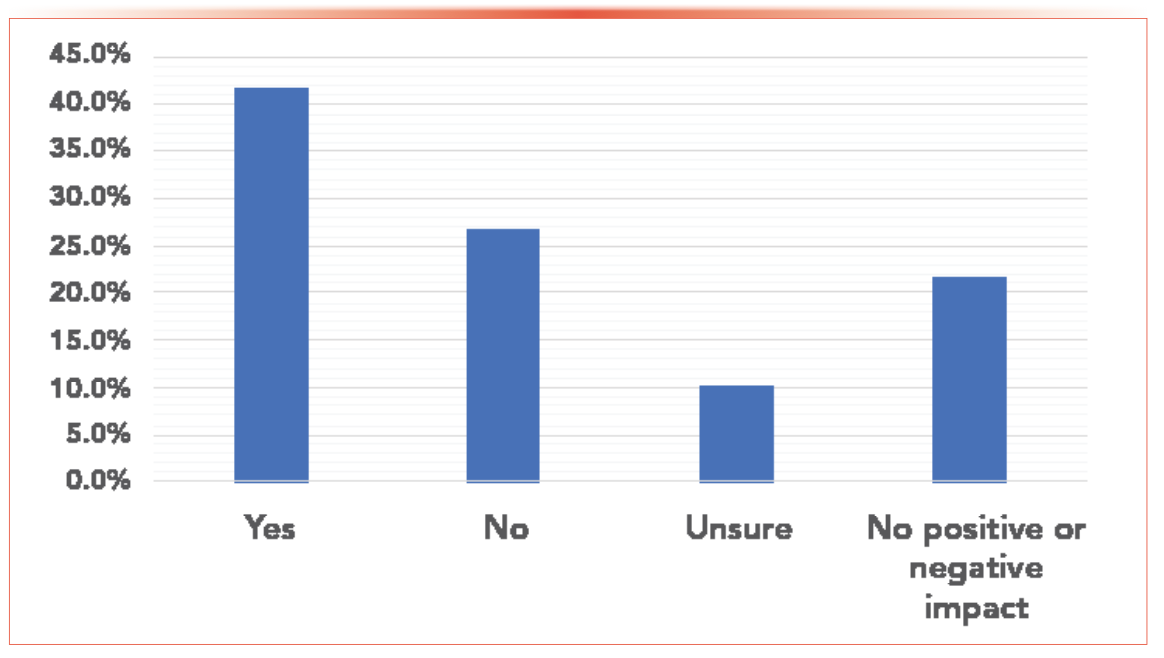
About 79% of respondents said that retention was impacted by RTO policies, though only fewer than 3% said that impact was severe (Figure 7). These latter data points seem somewhat in contradiction with the overall acceptance of the need to be on site.
FIGURE 7: A breakdown of how retention in the separation science industry has been impacted by RTO policies. The question respondents were asked was: “To what extent has your company’s RTO or in-office policy negatively impacted retention?”
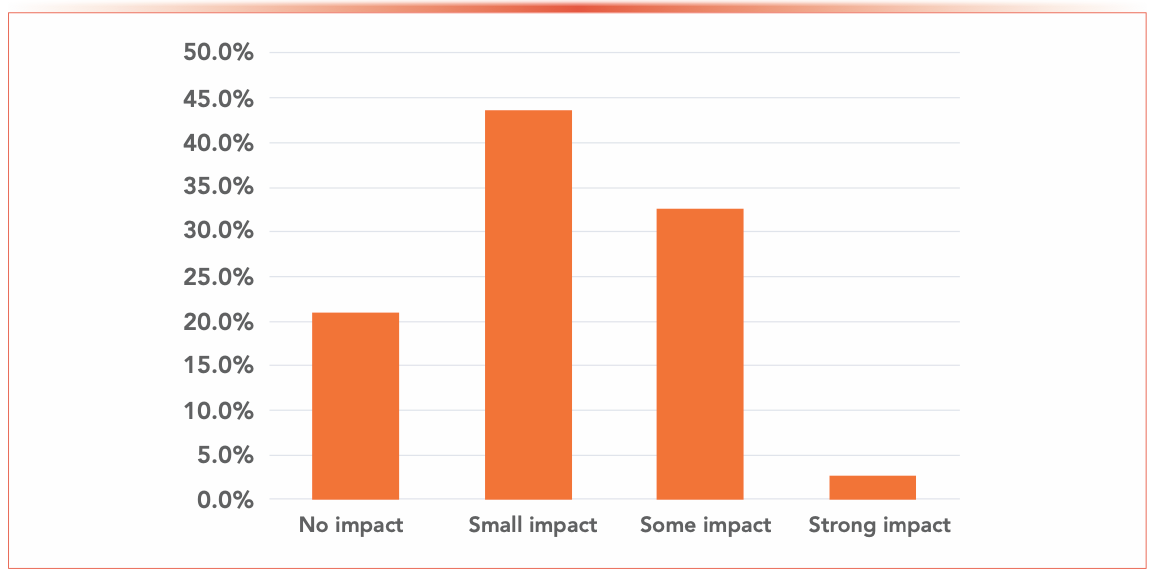
Assessing the Skills of New Separation Scientists
An area of particular concern to the field is the question of how well prepared young new hires are for the job challenges they will face. Respondents were asked to rate the skill sets of new hires and how prepared they are to handle the work their field entails. Table III showcases the results of this survey question.

Overall, more than 60% of respondents classified new employees’ skill sets as being “very good” or “exceptional,” and slightly under 40% of respondents commented that new hires had “poor” or merely “adequate” knowledge and skill sets for the roles that they were hired for. This is a vast improvement over what respondents said in 2021. In 2021, only 4% of respondents said new employees’ skill sets were “exceptional” and only 28% stated that new employees’ skill sets were “very good.”
We saw a similar trend when we asked respondents to weigh in on the skill sets of available job candidates. Table IV displays the results of this survey question. Here, more than 70% of respondents felt that new job candidates had either “good” or “excellent” skill sets, which is a statistic that is encouraging for employers trying to fill open roles. Once again, these figures represent a large increase from the results to this survey question last year. In 2021, the response for the survey were as follows—excellent (6%), good (40%), adequate (43%), and poor (11%) (4).

For those who rated new employee and job candidate skill sets as either “adequate” or “poor,” we asked respondents to comment on the skills they feel new hires and job candidates are lacking—allowing them to write in any response they chose. The skills that respondents said that new job candidates lack include: regulated environment experience; self-confidence; interpersonal communication skills; writing skills; presentation skills; knowing how to troubleshoot different instruments; a strong work ethic; critical thinking and reasoning; emotional intelligence; the ability to work and get along with others; high performance liquid chromatography (HPLC) and gas chromatography (GC) instrument use; and laboratory experience.
Instrumentation Knowledge
A sizable number of respondents commented that very few young professionals entering the industry have the breadth of instrumentation knowledge needed. There were two respondents who noted that many young professionals have a rudimentary understanding of C18 separations, for example. Two other respondents noted that GC and inductively coupled plasma–mass spectrometry (ICP-MS) experience were two techniques that new job candidates are not well-versed in. One respondent noted that none of the six candidates they interviewed for an open position knew anything about the van Deemter equation.
Soft Skills
Some of the soft skills that respondents mentioned were missing from the recent batch of job candidates were also missing from young professionals attempting to enter the field. As an example, interpersonal communication was frequently cited as a soft skill that was in high demand among new workers entering the field. More than 30 respondents noted that job candidates do not possess the interpersonal communication skills that they are looking for. Approximately 10 respondents also noted that new hires also do not possess the necessary patience to learn essential on-the-job skills. Other soft skills that were mentioned as lacking in new job candidates were presentation skills, the ability to handle stress, resourcefulness, and the ability to self-learn.
In collaboration with the American Chemical Society Analytical Division Subdivision on Chromatography and Separations Chemistry (ACS AD SCSC), we recently developed a survey to assess what technical and transferrable skills are most useful in industry. The hope is that that survey will provide useful information to educators in this field. It will also supplement what is discussed here. If you would like to provide any commentary on this topic, please click on the following link to access the survey: https://www.surveymonkey.com/r/NJHXHFB.
How Organizations are Responding to Current Economic Conditions
We asked respondents to comment on how their employers have responded to the current economic conditions. Over 26% of respondents said that their employer underwent a large merger or acquisition in 2022. In addition, a sizable percentage of respondents (70.2%) said that their companies restructured or downsized, with that breaking down to nearly 36% of all respondents saying that their organization downsized or restructured because of inflation, and 34.2% of respondents saying their company downsized or restructured for other reasons. A smaller percentage of respondents reported that their company offshored work functions (14.6%).
Conclusion
Separation science professionals, like all workers, are currently working through period of significant changes. Apart from the societal and cultural forces that are causing many workers to radically rethink the nature of work and how it applies to them, workers have seen big recent shifts from worker shortages that have led to higher salaries, followed quickly by spiking inflation that has decreased the purchasing power of their new salaries and left many feeling less economically secure.
However, despite these challenging issues, professionals in the separation science field are feeling optimistic and are overall satisfied with their current work life. As we look to 2023, we will see how the separation science field responds to new workplace trends and how they adapt to the new set of conditions before them.
References
(1) J. Workman, Jr., LCGC North Am. Resource Issue (12-01-20), 6–9 (2020).
(2) J. Workman, Jr., LCGC North Am. 37(8), 560–572 (2019).
(3) J. Romeo, LCGC North Am. 35(8), 544–551 (2017).
(4) J. Workman, Jr., LCGC North Am. 39(12), 593–599 (2021).
(5) M. Karydes and K. Bailie, Countries With The Highest Inflation: How U.S. Prices Compare Globally. https://www.forbes.com/advisor/personal-finance/inflation-by-country/ (accessed October 2022).
(6) Eurostat, Annual Inflation Up To 9.9% In The Euro Area. https://ec.europa.eu/eurostat/documents/2995521/15131946/2-19102022-AP-EN.pdf/92861d37-0275-8970-a0c1- 89526c25f392#:~:text=The%20euro%20 area%20annual%20inflation,%2C%20 the%20rate%20was%203.6%25 (accessed October 2022).
(7) T. Tepper, Why is Inflation So High? https://www.forbes.com/advisor/investing/why-is-inflation-rising-right-now/ (accessed October 2022).
Will Wetzel is an associate editor with LCGC and Spectroscopy. Direct correspondence to: wwetzel@mjhlifesciences.com.
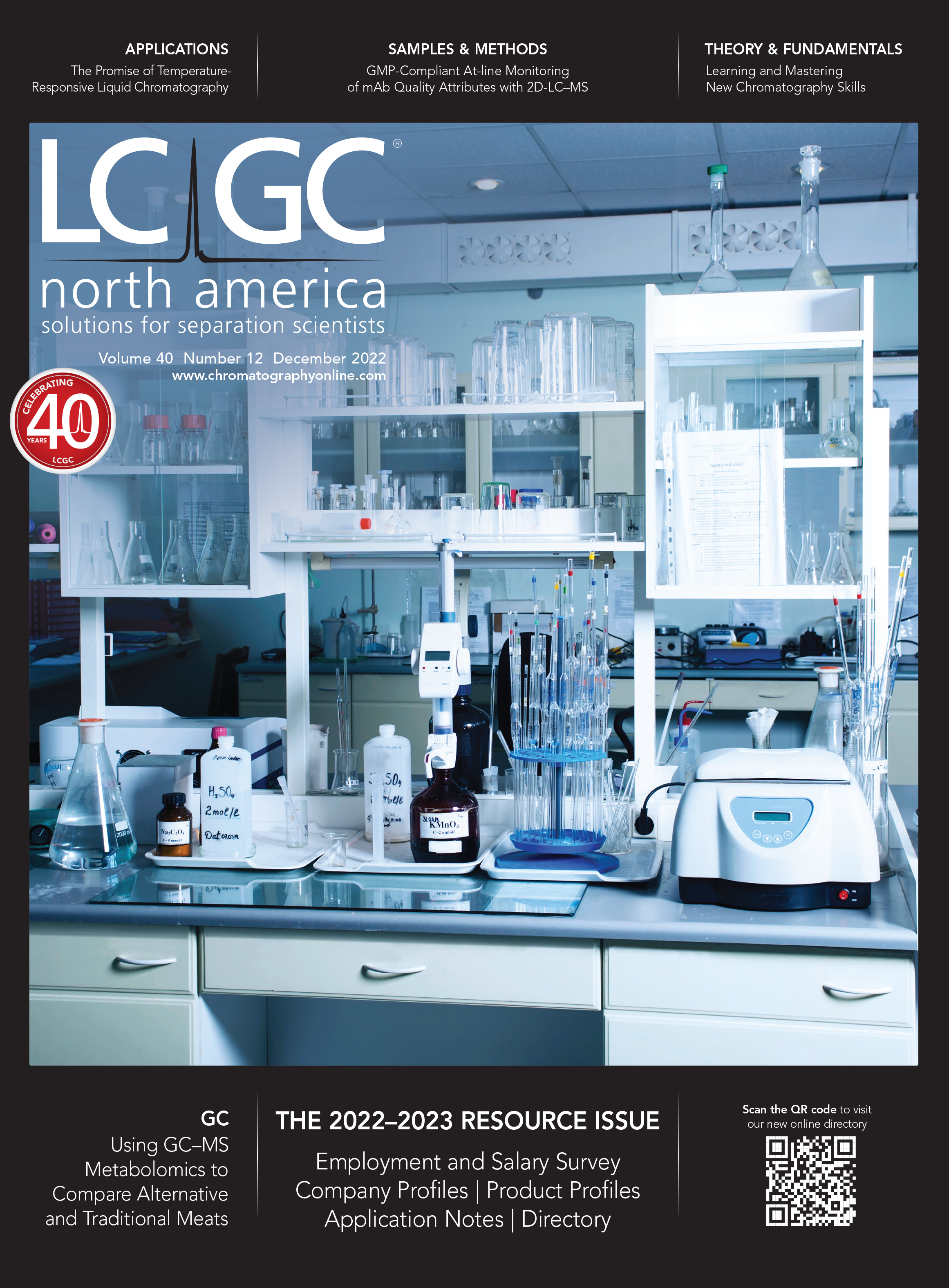
The 2025 Lifetime Achievement and Emerging Leader in Chromatography Awards
February 11th 2025Christopher A. Pohl and Katelynn A. Perrault Uptmor are the winners of the 18th annual LCGC Lifetime Achievement and Emerging Leader in Chromatography Awards, respectively. The LCGC Awards honor the work of talented separation scientists at different stages in their career (See Table I, accessible through the QR code at the end of the article). The award winners will be honored during an oral symposium at the Pittcon 2025 conference held March 1-5, in Boston, Massachusetts.
USP CEO Discusses Quality and Partnership in Pharma
December 11th 2024Ronald Piervincenzi, chief executive officer of the United States Pharmacoepia, focused on how collaboration and component quality can improve worldwide pharmaceutical production standards during a lecture at the Eastern Analytical Symposium (EAS) last month.

.png&w=3840&q=75)

.png&w=3840&q=75)



.png&w=3840&q=75)



.png&w=3840&q=75)






